Marta Lagomarsino
Human-Robot Interfaces and Interaction Laboratory, Istituto Italiano di Tecnologia, Genoa, Italy, Dept. of Electronics, Information and Bioengineering, Politecnico di Milano, Milan, Italy
A Human-in-the-loop Approach to Robot Action Replanning through LLM Common-Sense Reasoning
Jul 28, 2025Abstract:To facilitate the wider adoption of robotics, accessible programming tools are required for non-experts. Observational learning enables intuitive human skills transfer through hands-on demonstrations, but relying solely on visual input can be inefficient in terms of scalability and failure mitigation, especially when based on a single demonstration. This paper presents a human-in-the-loop method for enhancing the robot execution plan, automatically generated based on a single RGB video, with natural language input to a Large Language Model (LLM). By including user-specified goals or critical task aspects and exploiting the LLM common-sense reasoning, the system adjusts the vision-based plan to prevent potential failures and adapts it based on the received instructions. Experiments demonstrated the framework intuitiveness and effectiveness in correcting vision-derived errors and adapting plans without requiring additional demonstrations. Moreover, interactive plan refinement and hallucination corrections promoted system robustness.
Graph-based Online Monitoring of Train Driver States via Facial and Skeletal Features
May 09, 2025Abstract:Driver fatigue poses a significant challenge to railway safety, with traditional systems like the dead-man switch offering limited and basic alertness checks. This study presents an online behavior-based monitoring system utilizing a customised Directed-Graph Neural Network (DGNN) to classify train driver's states into three categories: alert, not alert, and pathological. To optimize input representations for the model, an ablation study was performed, comparing three feature configurations: skeletal-only, facial-only, and a combination of both. Experimental results show that combining facial and skeletal features yields the highest accuracy (80.88%) in the three-class model, outperforming models using only facial or skeletal features. Furthermore, this combination achieves over 99% accuracy in the binary alertness classification. Additionally, we introduced a novel dataset that, for the first time, incorporates simulated pathological conditions into train driver monitoring, broadening the scope for assessing risks related to fatigue and health. This work represents a step forward in enhancing railway safety through advanced online monitoring using vision-based technologies.
Mitigating Compensatory Movements in Prosthesis Users via Adaptive Collaborative Robotics
May 03, 2025Abstract:Prosthesis users can regain partial limb functionality, however, full natural limb mobility is rarely restored, often resulting in compensatory movements that lead to discomfort, inefficiency, and long-term physical strain. To address this issue, we propose a novel human-robot collaboration framework to mitigate compensatory mechanisms in upper-limb prosthesis users by exploiting their residual motion capabilities while respecting task requirements. Our approach introduces a personalised mobility model that quantifies joint-specific functional limitations and the cost of compensatory movements. This model is integrated into a constrained optimisation framework that computes optimal user postures for task performance, balancing functionality and comfort. The solution guides a collaborative robot to reconfigure the task environment, promoting effective interaction. We validated the framework using a new body-powered prosthetic device for single-finger amputation, which enhances grasping capabilities through synergistic closure with the hand but imposes wrist constraints. Initial experiments with healthy subjects wearing the prosthesis as a supernumerary finger demonstrated that a robotic assistant embedding the user-specific mobility model outperformed human partners in handover tasks, improving both the efficiency of the prosthesis user's grasp and reducing compensatory movements in functioning joints. These results highlight the potential of collaborative robots as effective workplace and caregiving assistants, promoting inclusion and better integration of prosthetic devices into daily tasks.
WiFi based Human Fall and Activity Recognition using Transformer based Encoder Decoder and Graph Neural Networks
Apr 23, 2025Abstract:Human pose estimation and action recognition have received attention due to their critical roles in healthcare monitoring, rehabilitation, and assistive technologies. In this study, we proposed a novel architecture named Transformer based Encoder Decoder Network (TED Net) designed for estimating human skeleton poses from WiFi Channel State Information (CSI). TED Net integrates convolutional encoders with transformer based attention mechanisms to capture spatiotemporal features from CSI signals. The estimated skeleton poses were used as input to a customized Directed Graph Neural Network (DGNN) for action recognition. We validated our model on two datasets: a publicly available multi modal dataset for assessing general pose estimation, and a newly collected dataset focused on fall related scenarios involving 20 participants. Experimental results demonstrated that TED Net outperformed existing approaches in pose estimation, and that the DGNN achieves reliable action classification using CSI based skeletons, with performance comparable to RGB based systems. Notably, TED Net maintains robust performance across both fall and non fall cases. These findings highlight the potential of CSI driven human skeleton estimation for effective action recognition, particularly in home environments such as elderly fall detection. In such settings, WiFi signals are often readily available, offering a privacy preserving alternative to vision based methods, which may raise concerns about continuous camera monitoring.
Exploiting Information Theory for Intuitive Robot Programming of Manual Activities
Oct 31, 2024



Abstract:Observational learning is a promising approach to enable people without expertise in programming to transfer skills to robots in a user-friendly manner, since it mirrors how humans learn new behaviors by observing others. Many existing methods focus on instructing robots to mimic human trajectories, but motion-level strategies often pose challenges in skills generalization across diverse environments. This paper proposes a novel framework that allows robots to achieve a \textit{higher-level} understanding of human-demonstrated manual tasks recorded in RGB videos. By recognizing the task structure and goals, robots generalize what observed to unseen scenarios. We found our task representation on Shannon's Information Theory (IT), which is applied for the first time to manual tasks. IT helps extract the active scene elements and quantify the information shared between hands and objects. We exploit scene graph properties to encode the extracted interaction features in a compact structure and segment the demonstration into blocks, streamlining the generation of Behavior Trees for robot replicas. Experiments validated the effectiveness of IT to automatically generate robot execution plans from a single human demonstration. Additionally, we provide HANDSOME, an open-source dataset of HAND Skills demOnstrated by Multi-subjEcts, to promote further research and evaluation in this field.
PRO-MIND: Proximity and Reactivity Optimisation of robot Motion to tune safety limits, human stress, and productivity in INDustrial settings
Sep 10, 2024Abstract:Despite impressive advancements of industrial collaborative robots, their potential remains largely untapped due to the difficulty in balancing human safety and comfort with fast production constraints. To help address this challenge, we present PRO-MIND, a novel human-in-the-loop framework that leverages valuable data about the human co-worker to optimise robot trajectories. By estimating human attention and mental effort, our method dynamically adjusts safety zones and enables on-the-fly alterations of the robot path to enhance human comfort and optimal stopping conditions. Moreover, we formulate a multi-objective optimisation to adapt the robot's trajectory execution time and smoothness based on the current human psycho-physical stress, estimated from heart rate variability and frantic movements. These adaptations exploit the properties of B-spline curves to preserve continuity and smoothness, which are crucial factors in improving motion predictability and comfort. Evaluation in two realistic case studies showcases the framework's ability to restrain the operators' workload and stress and to ensure their safety while enhancing human-robot productivity. Further strengths of PRO-MIND include its adaptability to each individual's specific needs and sensitivity to variations in attention, mental effort, and stress during task execution.
Maximising Coefficiency of Human-Robot Handovers through Reinforcement Learning
Jun 12, 2023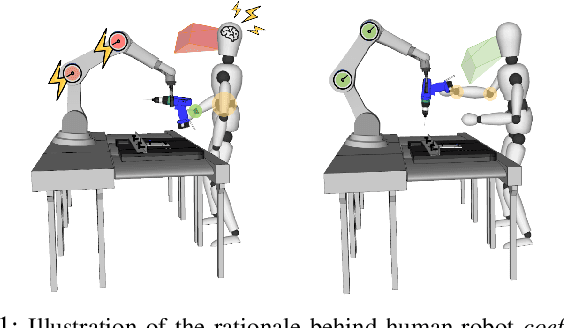
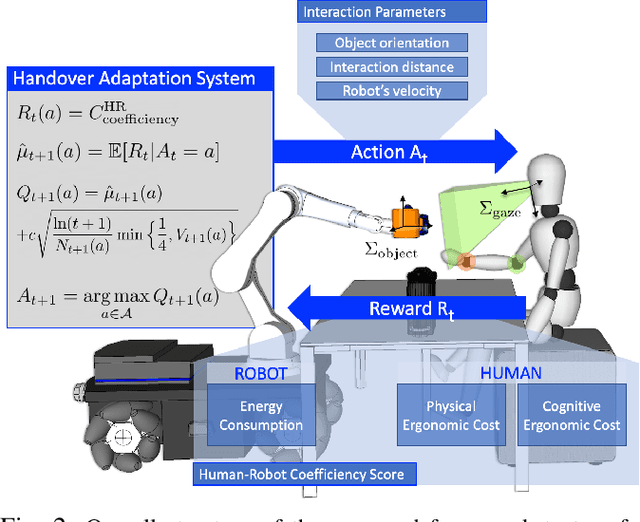
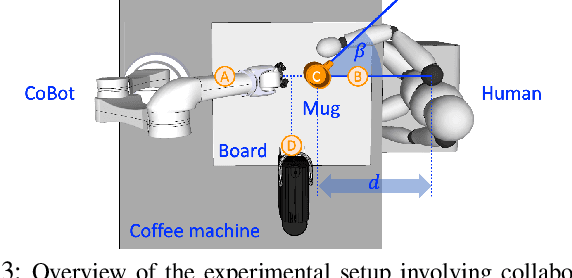
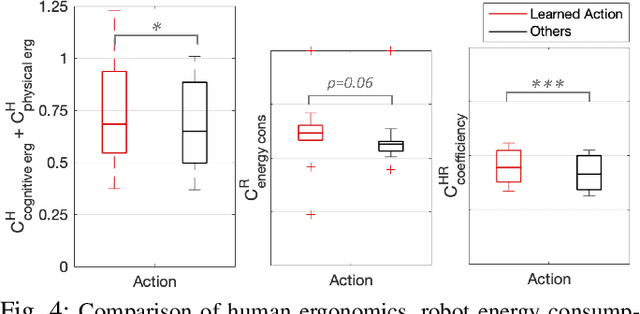
Abstract:Handing objects to humans is an essential capability for collaborative robots. Previous research works on human-robot handovers focus on facilitating the performance of the human partner and possibly minimising the physical effort needed to grasp the object. However, altruistic robot behaviours may result in protracted and awkward robot motions, contributing to unpleasant sensations by the human partner and affecting perceived safety and social acceptance. This paper investigates whether transferring the cognitive science principle that "humans act coefficiently as a group" (i.e. simultaneously maximising the benefits of all agents involved) to human-robot cooperative tasks promotes a more seamless and natural interaction. Human-robot coefficiency is first modelled by identifying implicit indicators of human comfort and discomfort as well as calculating the robot energy consumption in performing the desired trajectory. We then present a reinforcement learning approach that uses the human-robot coefficiency score as reward to adapt and learn online the combination of robot interaction parameters that maximises such coefficiency. Results proved that by acting coefficiently the robot could meet the individual preferences of most subjects involved in the experiments, improve the human perceived comfort, and foster trust in the robotic partner.
Automatic Interaction and Activity Recognition from Videos of Human Manual Demonstrations with Application to Anomaly Detection
Apr 19, 2023


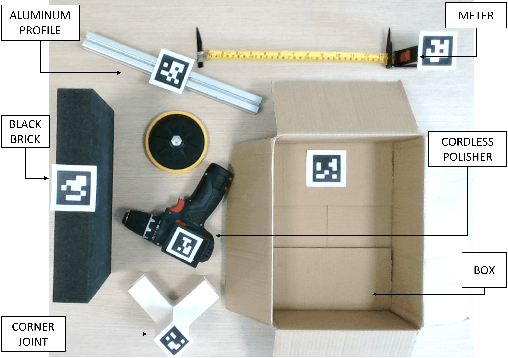
Abstract:This paper presents a new method to describe spatio-temporal relations between objects and hands, to recognize both interactions and activities within video demonstrations of manual tasks. The approach exploits Scene Graphs to extract key interaction features from image sequences, encoding at the same time motion patterns and context. Additionally, the method introduces an event-based automatic video segmentation and clustering, which allows to group similar events, detecting also on the fly if a monitored activity is executed correctly. The effectiveness of the approach was demonstrated in two multi-subject experiments, showing the ability to recognize and cluster hand-object and object-object interactions without prior knowledge of the activity, as well as matching the same activity performed by different subjects.
Gestural and Touchscreen Interaction for Human-Robot Collaboration: a Comparative Study
Jul 08, 2022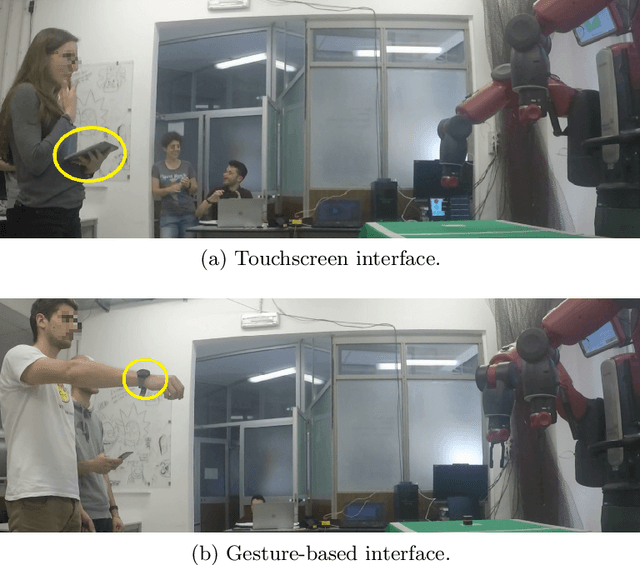
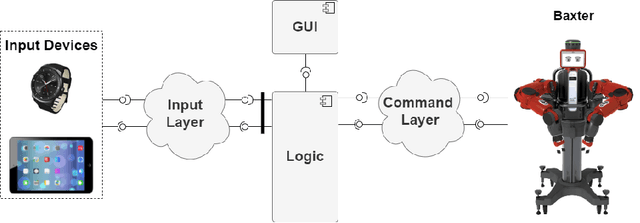
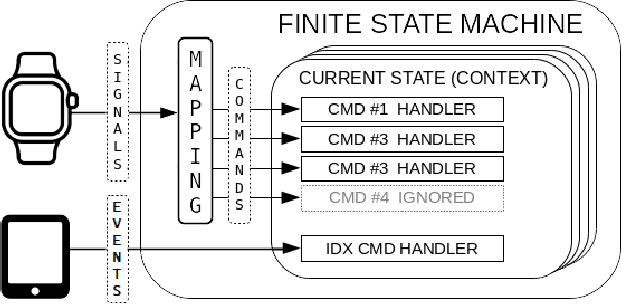

Abstract:Close human-robot interaction (HRI), especially in industrial scenarios, has been vastly investigated for the advantages of combining human and robot skills. For an effective HRI, the validity of currently available human-machine communication media or tools should be questioned, and new communication modalities should be explored. This article proposes a modular architecture allowing human operators to interact with robots through different modalities. In particular, we implemented the architecture to handle gestural and touchscreen input, respectively, using a smartwatch and a tablet. Finally, we performed a comparative user experience study between these two modalities.
Pick the Right Co-Worker: Online Assessment of Cognitive Ergonomics in Human-Robot Collaborative Assembly
Jul 08, 2022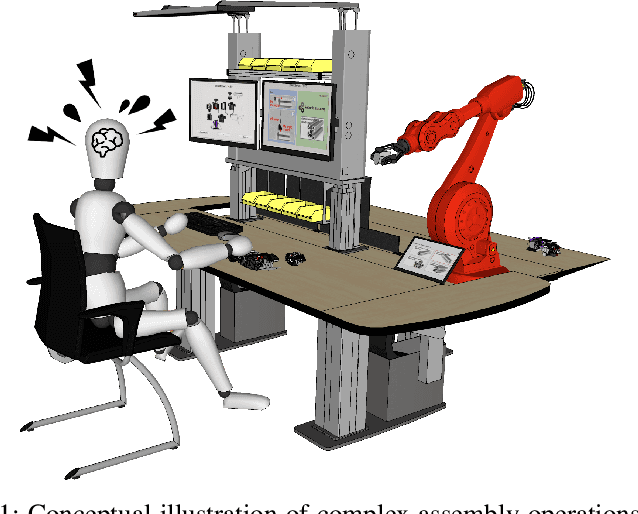
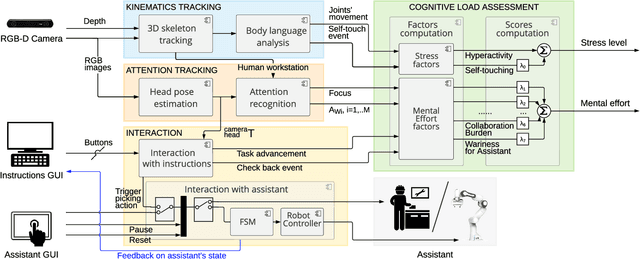

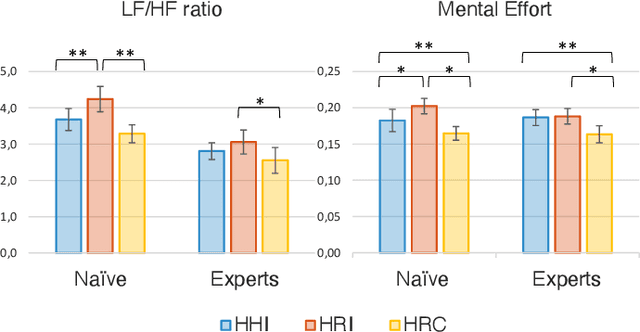
Abstract:Human-robot collaborative assembly systems enhance the efficiency and productivity of the workplace but may increase the workers' cognitive demand. This paper proposes an online and quantitative framework to assess the cognitive workload induced by the interaction with a co-worker, either a human operator or an industrial collaborative robot with different control strategies. The approach monitors the operator's attention distribution and upper-body kinematics benefiting from the input images of a low-cost stereo camera and cutting-edge artificial intelligence algorithms (i.e. head pose estimation and skeleton tracking). Three experimental scenarios with variations in workstation features and interaction modalities were designed to test the performance of our online method against state-of-the-art offline measurements. Results proved that our vision-based cognitive load assessment has the potential to be integrated into the new generation of collaborative robotic technologies. The latter would enable human cognitive state monitoring and robot control strategy adaptation for improving human comfort, ergonomics, and trust in automation.
 Add to Chrome
Add to Chrome Add to Firefox
Add to Firefox Add to Edge
Add to Edge